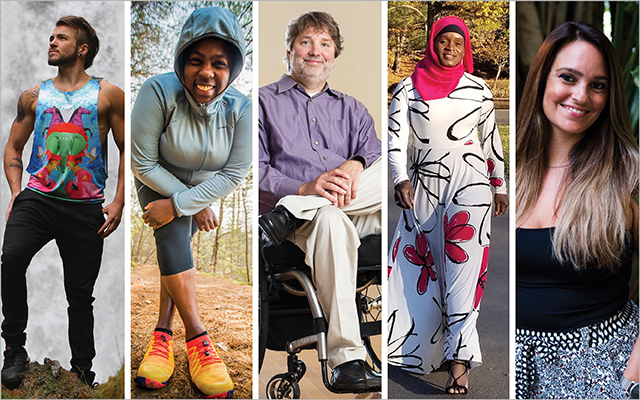If you watch the Summer Olympics, you may notice the physical resemblance between athletes competing in the same event. Gymnasts tend to have small, compact frames; swimmers have long limbs and a broad chest; long-distance runners are medium height with delicate torsos and powerful legs. Bodies come in all shapes and sizes, but specific body types tend to favor specific sports. By analyzing your build, height and mass, you can discover the most suitable fitness activities for your body, and perhaps a hidden athletic talent.
Explore this article:
Even if you’re not interested in pursuing Olympic gold, you can learn to analyze your body and develop a well-rounded fitness routine that exploits your physical attributes and considers your limitations. For example, you might have a difficult time following the quick moves of a wiry aerobics instructor but discover you have a distinct advantage in the pool or an excellent build for cycling, volleyball or racquet sports.
Knowing your body type and adapting a routine that matches your dominant genetic predisposition also can mean the difference between fun and frustration. For example, a tendency to accumulate fat can be a severe disadvantage for a long-distance runner, but not for a swimmer, who must maintain body heat and buoyancy. So instead of bemoaning your build and exercising in ways that don’t suit you, celebrate your body type. Every body has its advantages; knowing your morphological tendency is the first step toward identifying your hidden athletic aptitude.
Training for Your Body Type
In an effort to understand the differences between body types, the late physiologist William Sheldon worked out a classification system that is still widely used today. He sorted body types into three categories:
- Endomorph: round and voluptuous
- Mesomorph: muscular with large bones
- Ectomorph: thin and tall
Although your body probably doesn’t fall exactly into one of Sheldon’s three standard types, you will recognize your general propensity. Odds are that you probably fall somewhere between two body types. For example, you may have a medium-strong build that tends to accumulate lower-body fat. In that case, you have both mesomorphic and endomorphic qualities. This knowledge may seem like an arcane bit of trivia, until you consider that your body type (in some cases, even more than training and diet) determines your shot at full-on success in any fitness endeavor.
Bodybuilders were the first to take Sheldon’s categories to heart and use them to tailor training and diet to specific body types. For instance, an ectomorph, with tendencies toward a slight build, would have to consume more calories, perform heavier sets and reduce aerobic exercise to build muscle. An endomorph, tending toward a larger frame, but with a propensity to accumulate fat, would have to eat fewer calories, perform a more vigorous workout, with less rest and higher repetitions, and include more aerobic exercise in his or her routine to control fat.
But despite the best efforts of either an ecto- or endomorph, he or she will have a hard time competing in bodybuilding with a mesomorph. In fact, almost every Mr. Olympia was an extreme mesomorph. In comparison, every marathon champion has been an ectomorph, of thin, light structure.
Sprinters and middle-distance runners tend toward a lean but more muscular build — somewhere between the ectomorph and mesomorph. Football linebackers, shot-putters and even some rowers, on the other hand, are more likely to combine mesomorph and endomorph qualities.
This certainly does not mean that someone with a heavy frame, short limbs and a tendency to accumulate muscle and fat cannot train to run a marathon; they just probably won’t win the event. On the other hand, this person would likely find quick success in the weight room, where short powerful limbs and well-developed muscles provide a distinct advantage.
Although it’s always recommended that you cross-train and balance your natural tendencies, it’s also fun to experience ease and success. A fitness routine you can most easily maintain over time is also one you enjoy. So instead of focusing your fitness ambitions on activities for which your body’s physiology was never optimally designed, consider emphasizing (or at least incorporating) some that are better suited for your specific body type — activities you’ll excel at, enjoy and continue.
As noted, your body may not fit exactly into one category. Let’s say you have primarily a mesomorph body type but also share endomorphic characteristics: You would probably combine elements from each routine to maximize your results. For example, you might consider a strength-training routine that includes interval training on cardio equipment to help you burn off a few extra calories and control fat.
If you have endomorphic tendencies, perhaps you should add some distance cycling. Either way, try to work with your dominant body type at first, and then make the necessary adjustments to complement your other characteristics down the road.
Endomorph
- Physical characteristics: Stout and round; strong bones
- Metabolic characteristics: Slower metabolism; often carries some excess body fat
- Training positives: Naturally strong; quick to gain muscle
- Training negatives: Difficult time losing weight
Best Physical Activities for Endomorphs
Cardiovascular exercise. People with an endomorphic body find it easier to gain rather than lose weight. Consequently, you’ll find many endomorphs pounding away on the treadmill. Yet excess weight, whether fat or muscle, can be hard on the joints. Instead of trying to jog, consider race walking, swimming, rowing and cycling.
Along with a propensity to store fat, endomorphs can pack on muscle mass. Consider that every offensive and defensive lineman in the NFL has strong endomorphic characteristics. With shorter limbs, strong bones and well-developed upper arms and legs, endomorphs have an ideal body for powerlifting. But in order to maintain a healthy ratio between body weight and strength, you ought to supplement your free-weight exercises with a regimen of body-weight exercises, like pushups and pull-ups.
While you won’t be a calisthenics champ, try to maintain a body weight that allows you to do at least 15 pushups and three to five chin-ups if you’re a woman and 25 pushups and five to 10 pull-ups if you’re a man. To burn fat while lifting, keep your rest periods to 30 seconds between sets. You may have to lower the weight until you get used to it, but you’ll work up a sweat and burn plenty of calories.
Best Sports for Endomorphs
Sports. If you’re not into football, you might consider long-distance swimming. Open-water swimmers have less muscle definition and tend to carry more fat than other athletes, but this helps with insulation and buoyancy. Rowing is also an excellent choice; rowers tend to be heavier athletes with broad shoulders and long, powerful limbs. Winter sports like cross-country skiing and snowshoeing are also ideal activities that will help you control your weight while taking advantage of your slow, endurance-oriented metabolism.
Mesomorph
- Physical characteristics: Muscular and athletic
- Metabolic characteristics: Gains and loses weight easily
- Training positives: Responds well to both resistance and aerobic training
- Training negatives: Can quickly overtrain; needs variety in workouts
Best Physical Activities for Mesomorphs
Cardiovascular exercise. Although mesomorphs tend to have broad shoulders, muscular limbs and narrow waists, they can still store fat if not careful. But since a muscled upper body can hinder endurance activities, such as distance cycling and marathon running, concentrate instead on sprinting and middle-distance events. Three-, 5- and 10-kilometer races, and 5- to 20-mile bike rides are ideal for mesomorphs.
Also, try interval training, shuttle runs, sprints and track workouts to take advantage of fast-twitch muscles and athletic aptitude. Having an all-around athletic build, mesomorphs tend to make good triathletes, with the upper-body strength and broad shoulders to pull themselves through the water, yet they’re lean enough to efficiently cycle and run.
Strength training. Mesomorphs rule the weight room. Many personal trainers, bodybuilders and most athletes have this body type, tending toward a muscular, “V”-shaped or hourglass torso, depending on their gender. But the benefit of developing muscle quickly also represents the paradoxical Achilles’ heel of mesomorphs, who sometimes focus on one muscle group at the expense of symmetry. You’ll see this happen to men, who cultivate powerful arms and a barrel chest but stand on spindly legs that seem strangely out of proportion.
Mesomorph men who easily develop muscle and shed fat should keep their training focused on technique and balance, working all the muscle groups, including the legs. Follow strict form and work out three days a week. You don’t need to push to the extreme, unless you intend to compete. In that case, select weight-training exercises that strengthen the muscles predominantly used in your sport. Mesomorphs also often have poor flexibility, so don’t forget to make stretching a regular part of your routine.
Best Sports for Mesomorphs
Sports. Mesomorphs excel at weightlifting, bodybuilding and power sports that combine endurance and strength. Soccer, hockey and rugby players are generally mesomorphs of average stature.
Ectomorph
- Physical characteristics: Tall and lean; small chest, thin hips
- Metabolic characteristics: Fast metabolism and slow muscle gains
- Training positives: Naturally fit; weight loss comes easily
- Training negatives: Slow to gain muscle; exercise may cause weight loss
Best Physical Activities for Ectomorphs
Cardiovascular exercise. Ectomorphs are tall and lean, with a slight build, so they should consider long-distance running, cycling and pool swimming. Their long limbs provide an advantage in the water and their slight upper body means their legs don’t have to haul as much weight. Since they don’t tend to accumulate fat, ectomorphs should focus on technique and train like performance athletes, such as developing a formal periodization program to maximize fitness returns, as opposed to grinding out a lot of low-intensity miles on the treadmill.
Strength training. Ectomorphs have a slight upper body and small shoulders. You have the ability to gain strength without bulk, but if you want to gain upper-body muscle for a more proportional appearance, you’ll have to consume more calories than you expend and work out frequently with heavier weight. Your fast metabolism allows you to recover quickly, so you can handle five weight sessions a week. Cut back on the aerobics, since this will hamper your muscle building.
Make sure to eat a high-carbohydrate and -protein meal after every workout to help build muscle. Ectomorphs often have a fast metabolism and usually have difficulty adding muscle.
If you want to gain strength without added muscle weight, focus on low-repetition, heavyweight exercises that train you to develop tension. For example, instead of performing 50 pushups, do sets of three bench presses at 80 to 90 percent of your one-repetition maximum. This ensures a strong stimulus to your nervous system (the source of most of your strength) while not burning excess calories or stimulating hypertrophy (muscle growth).
Best Sports for Ectomorphs
Sports. Ectomorphs dominate marathons, triathlons, cross-country skiing, and other long-distance and endurance events. All of these sports require light musculature and little fat, relying on aerobic endurance more than power. Ectomorphs also tend to do well in racquet sports, such as squash and tennis, where their long limbs can compensate for slower sprints and changes in direction. At the gym, try indoor cycling, body sculpting and circuit training, and group classes that don’t require following a fast-paced choreography.
This article has been updated and originally appeared as “Just Your Type” in the January/February 2005 issue of Experience Life.





This Post Has 0 Comments